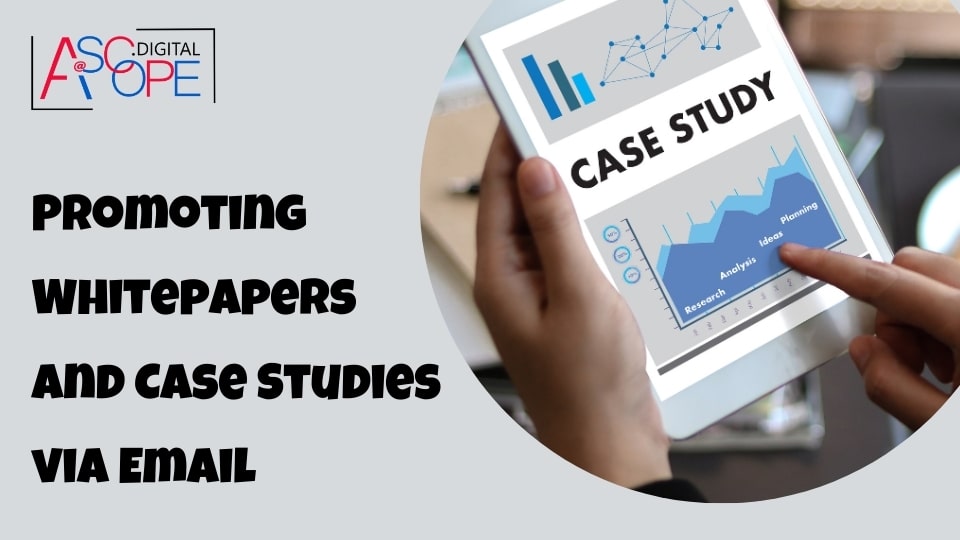In the B2B (business-to-business) landscape, content is king, and nothing reigns more supreme than whitepapers and case studies. These long-form pieces of content are not only crucial for establishing thought leadership but are also instrumental in nurturing leads through the sales funnel. However, creating these content assets is only half the battle; the real challenge lies in effectively promoting them. One of the most efficient ways to distribute whitepapers and case studies is through email marketing. This comprehensive guide will walk you through the strategies, best practices, and tips to promote whitepapers and case studies via email marketing, ultimately improving traffic and sales for your website.
Understanding the Importance of Whitepapers and Case Studies
Whitepapers and case studies serve distinct but complementary purposes in B2B marketing. Whitepapers are authoritative reports or guides that inform readers about complex issues, providing in-depth solutions or insights. They are particularly effective in showcasing a company’s expertise and are often used during the awareness and consideration stages of the buyer’s journey.
On the other hand, case studies offer real-world examples of how your products or services have been successfully implemented by clients. They provide tangible proof of your value proposition and are incredibly persuasive during the decision-making stage.
By leveraging both types of content, you can address different concerns and needs of your target audience at various stages of their journey. However, to maximize their impact, you need to ensure they reach the right audience, and email marketing is a powerful tool to achieve this.
Crafting the Perfect Email Campaign
To promote your whitepapers and case studies effectively, you need to craft email campaigns that capture attention and drive action. Here are some key components to consider:
- Subject Line: The subject line is the first thing your recipients will see, and it significantly influences whether they will open your email. It should be compelling, clear, and promise value. For example, “Discover How [Your Company] Solved [Client’s Problem]” for a case study or “Unlock Expert Insights on [Topic]” for a whitepaper.
- Personalization: Personalized emails tend to perform better than generic ones. Use the recipient’s name and, if possible, tailor the content based on their industry, job role, or previous interactions with your brand. Personalized greetings and relevant content can make a significant difference.
- Compelling Copy: The body of your email should be concise yet informative. Highlight the key takeaways of the whitepaper or case study and explain why it’s valuable to the recipient. Use bullet points or numbered lists to make the content easy to digest.
- Clear Call to Action (CTA): Your email should have a clear and prominent CTA. Whether it’s “Download the Whitepaper” or “Read the Case Study,” make sure the CTA stands out and is easy to click. Consider using buttons instead of text links for higher visibility.
- Visual Appeal: Use visuals to enhance your email. Include images of the whitepaper or case study cover, infographics, or client logos (with permission). Visual elements can make your email more engaging and help break up the text.
Segmentation and Targeting

One of the strengths of email marketing is the ability to segment your audience. By dividing your email list into smaller groups based on specific criteria, you can send more targeted and relevant content. Here’s how to segment your audience for promoting whitepapers and case studies:
- Industry: Tailor your content to address industry-specific challenges and solutions. For instance, a whitepaper on cybersecurity would be highly relevant to IT professionals but less so to HR managers.
- Job Role: Different roles within a company have different pain points and interests. C-level executives might be interested in strategic insights, while technical staff may look for detailed case studies.
- Engagement Level: Segment your audience based on their previous interactions with your emails and website. Send more detailed content to engaged users and introductory content to those less familiar with your brand.
- Buyer’s Journey Stage: Tailor your emails to the recipient’s stage in the buyer’s journey. Awareness-stage prospects might benefit from educational whitepapers, while decision-stage leads might be more interested in case studies demonstrating your success.
Timing and Frequency
Timing is crucial in email marketing. Sending your emails at the right time can significantly impact open and click-through rates. Generally, mid-week (Tuesday to Thursday) and mid-morning (10 AM) tend to be optimal times for sending B2B emails. However, it’s important to analyze your audience’s behavior and adjust your timing accordingly.
Frequency is another important factor. While it’s essential to stay top-of-mind, bombarding your audience with too many emails can lead to unsubscribes. A balanced approach is to send emails regularly but not excessively, ensuring each email provides genuine value.
Designing High-Converting Landing Pages
Once a recipient clicks on your email’s CTA, they should be directed to a well-designed landing page. This page should be focused on converting visitors into leads by encouraging them to download the whitepaper or read the case study. Here are some tips for creating high-converting landing pages:
- Consistent Messaging: Ensure that the landing page aligns with the email content. The headline, visuals, and copy should reinforce the value proposition mentioned in the email.
- Simple Form: Minimize the number of fields in your form to reduce friction. Typically, asking for a name, email address, and company name is sufficient. The easier it is to fill out, the higher the conversion rate.
- Clear CTA: The CTA on the landing page should be prominent and clear. Use action-oriented language such as “Download Now” or “Get the Case Study.”
- Trust Signals: Include trust signals such as client logos, testimonials, and security badges to reassure visitors of the credibility and safety of their information.
Follow-Up Strategy
Promoting whitepapers and case studies via email doesn’t end with a single campaign. Follow-up emails are essential for nurturing leads and encouraging further engagement. Here’s how to structure your follow-up strategy:
- Thank You Email: Immediately after a recipient downloads a whitepaper or reads a case study, send a thank-you email. This email should confirm their action and provide additional value, such as related content or an invitation to a webinar.
- Content Drip Campaign: Develop a series of follow-up emails that gradually provide more information and insights. For example, after sending a whitepaper, you could follow up with related blog posts, additional case studies, or an invitation to a product demo.
- Survey and Feedback: Ask for feedback on the whitepaper or case study. This not only shows that you value their opinion but also provides valuable insights to improve future content.
- Nurturing Towards Conversion: Gradually guide your leads towards a conversion point, whether it’s scheduling a demo, speaking with a sales representative, or making a purchase. Use the data from their interactions to personalize and tailor your communications.
Measuring Success
To understand the effectiveness of your email campaigns, it’s crucial to measure and analyze key metrics. Here are some metrics to track:
- Open Rate: The percentage of recipients who open your email. A high open rate indicates that your subject line and sender name are compelling.
- Click-Through Rate (CTR): The percentage of recipients who clicked on your CTA. A high CTR suggests that your email content and CTA are engaging and relevant.
- Conversion Rate: The percentage of recipients who completed the desired action on the landing page. This metric shows how effectively your email and landing page work together to drive conversions.
- Bounce Rate: The percentage of emails that couldn’t be delivered. A high bounce rate can indicate issues with your email list quality.
- Unsubscribe Rate: The percentage of recipients who unsubscribed after receiving your email. A high unsubscribe rate might indicate that you’re sending emails too frequently or that the content isn’t relevant to the audience.
By regularly analyzing these metrics, you can identify areas for improvement and optimize your email campaigns for better performance.
Case Study: A Real-World Example

Let’s consider a real-world example to illustrate how these strategies can be applied. Company X, a B2B software provider, created a whitepaper on “Enhancing Cybersecurity in Remote Work Environments.” They decided to promote this whitepaper through an email campaign targeting IT managers and security professionals.
Step 1: Crafting the Email Campaign
- Subject Line: “Secure Your Remote Workforce: Download Our Expert Whitepaper”
- Personalization: The email addressed recipients by name and mentioned their company’s industry.
- Compelling Copy: The email highlighted key insights from the whitepaper, such as best practices and case studies.
- CTA: “Download the Whitepaper” button was prominently placed.
- Visual Appeal: The email included an image of the whitepaper cover and relevant icons.
Step 2: Segmentation and Targeting
- Industry: Emails were sent to IT managers in sectors like finance, healthcare, and technology.
- Engagement Level: Highly engaged users received additional related content, while new leads received introductory information about Company X and their whitepapers.
Step 3: Designing the Landing Page
- Consistent Messaging: The landing page headline matched the email’s subject line about whitepapers.
- Simple Form: The form only asked for the recipient’s name, email, and company.
- Clear CTA: A prominent “Download Now” button.
- Trust Signals: Client logos and a testimonial from a satisfied customer who benefited from Company X’s whitepapers.
Step 4: Follow-Up Strategy
- Thank You Email: Sent immediately after the whitepaper download, with links to related blog posts and other whitepapers.
- Content Drip Campaign: A series of emails provided additional cybersecurity tips, case studies, and an invitation to a webinar.
- Survey and Feedback: A short survey asked recipients for their feedback on the whitepaper and other whitepapers.
- Nurturing Towards Conversion: Personalized emails guided leads towards scheduling a demo with Company X’s sales team, leveraging the information in their whitepapers.
Step 5: Measuring Success
- Open Rate: 28%
- CTR: 14%
- Conversion Rate: 8%
- Bounce Rate: 1%
- Unsubscribe Rate: 0.5%
By following these steps, Company X successfully promoted their whitepaper, generating high engagement and quality leads. The use of whitepapers in their marketing strategy proved effective in reaching and engaging their target audience.
Conclusion
Promoting whitepapers and case studies via email marketing is a powerful strategy for B2B companies looking to establish thought leadership, nurture leads, and drive conversions. By crafting compelling email campaigns, segmenting and targeting your audience, designing high-converting landing pages, implementing a follow-up strategy, and measuring success, you can effectively leverage these content assets to achieve your marketing goals.
Remember, the key to successful email marketing lies in delivering value to your audience. By providing insightful and relevant content, you can build trust and foster long-term relationships with your prospects. Thus, improving traffic and sales for your website. Read more on the other reasons why your website isn’t getting traffic and explore various strategies to overcome these challenges


